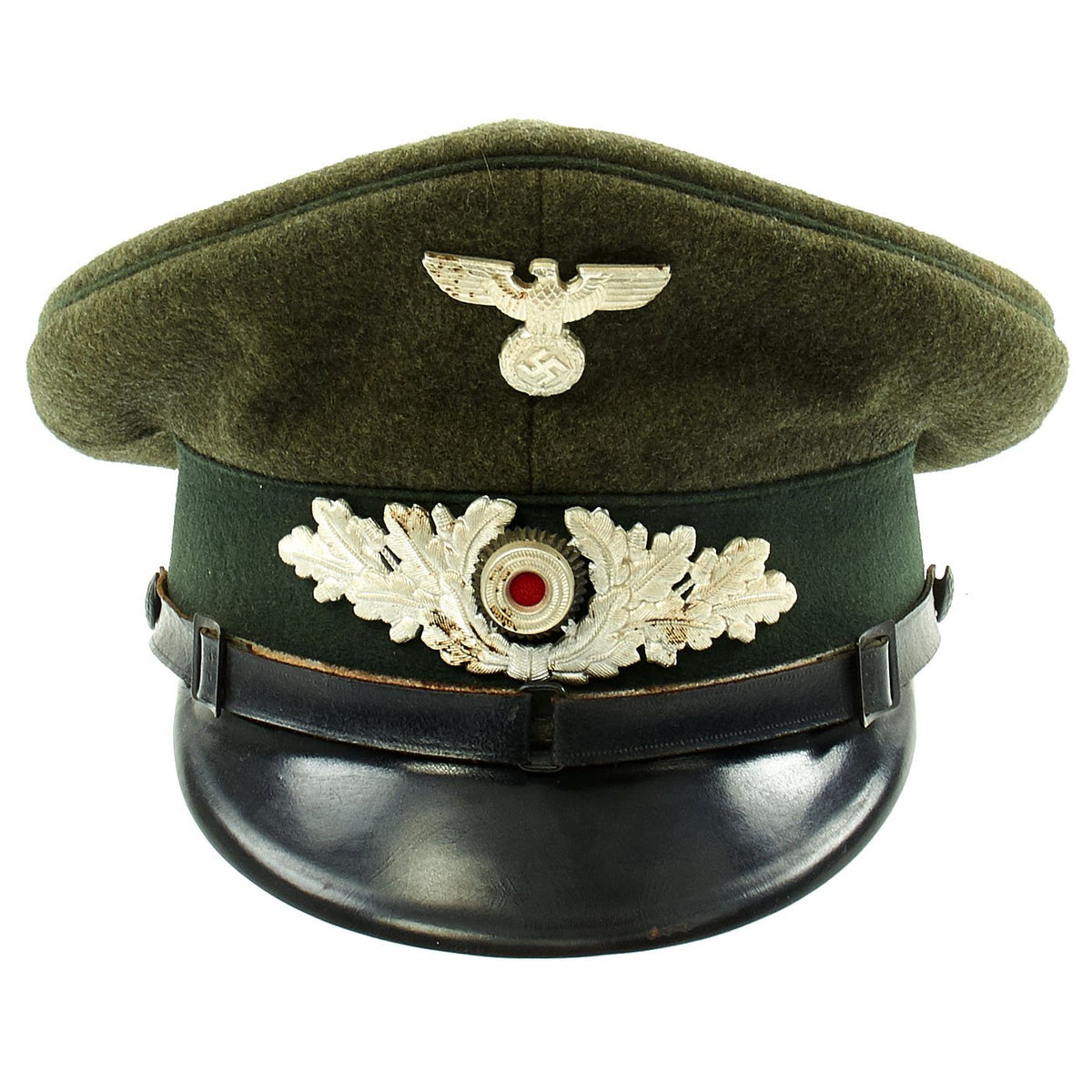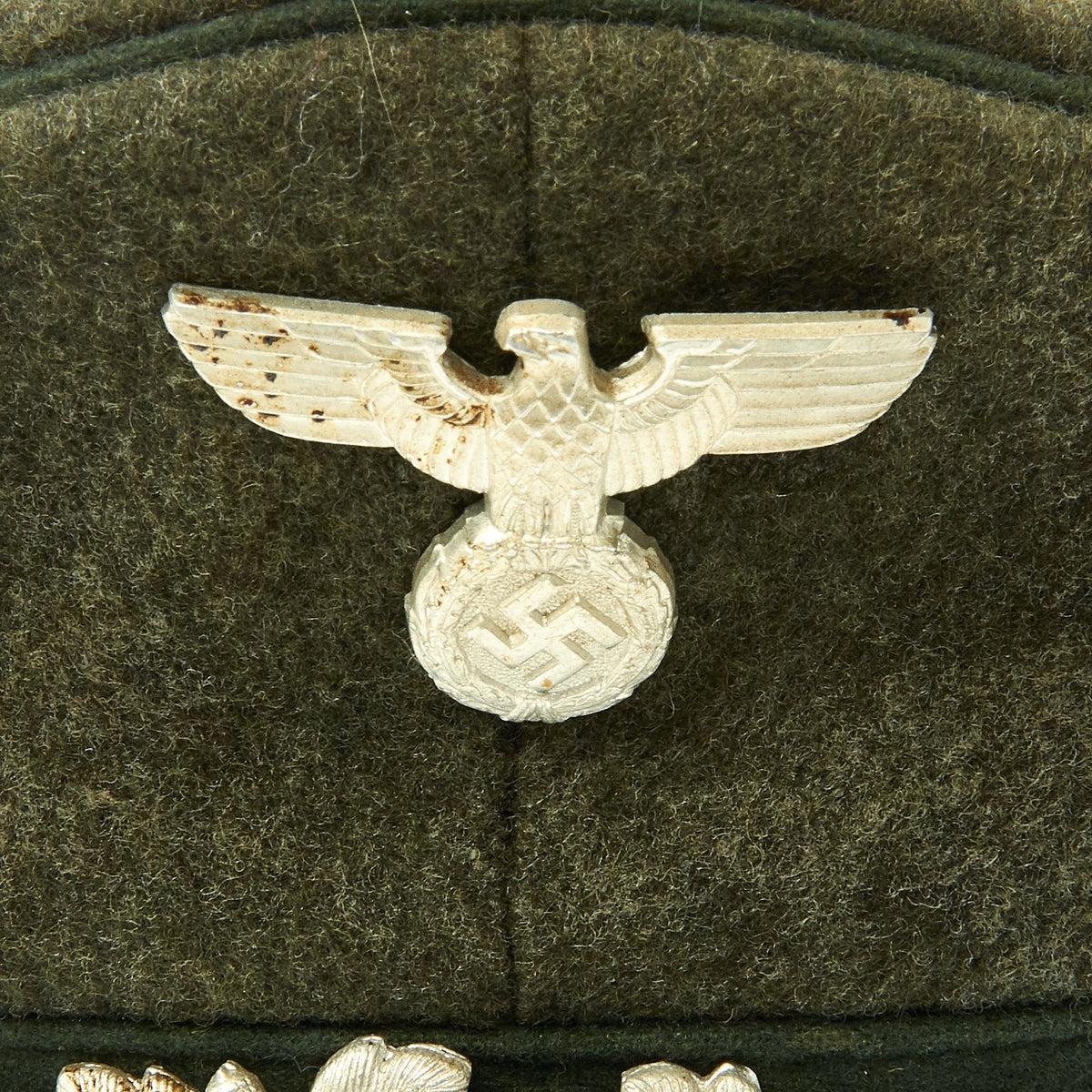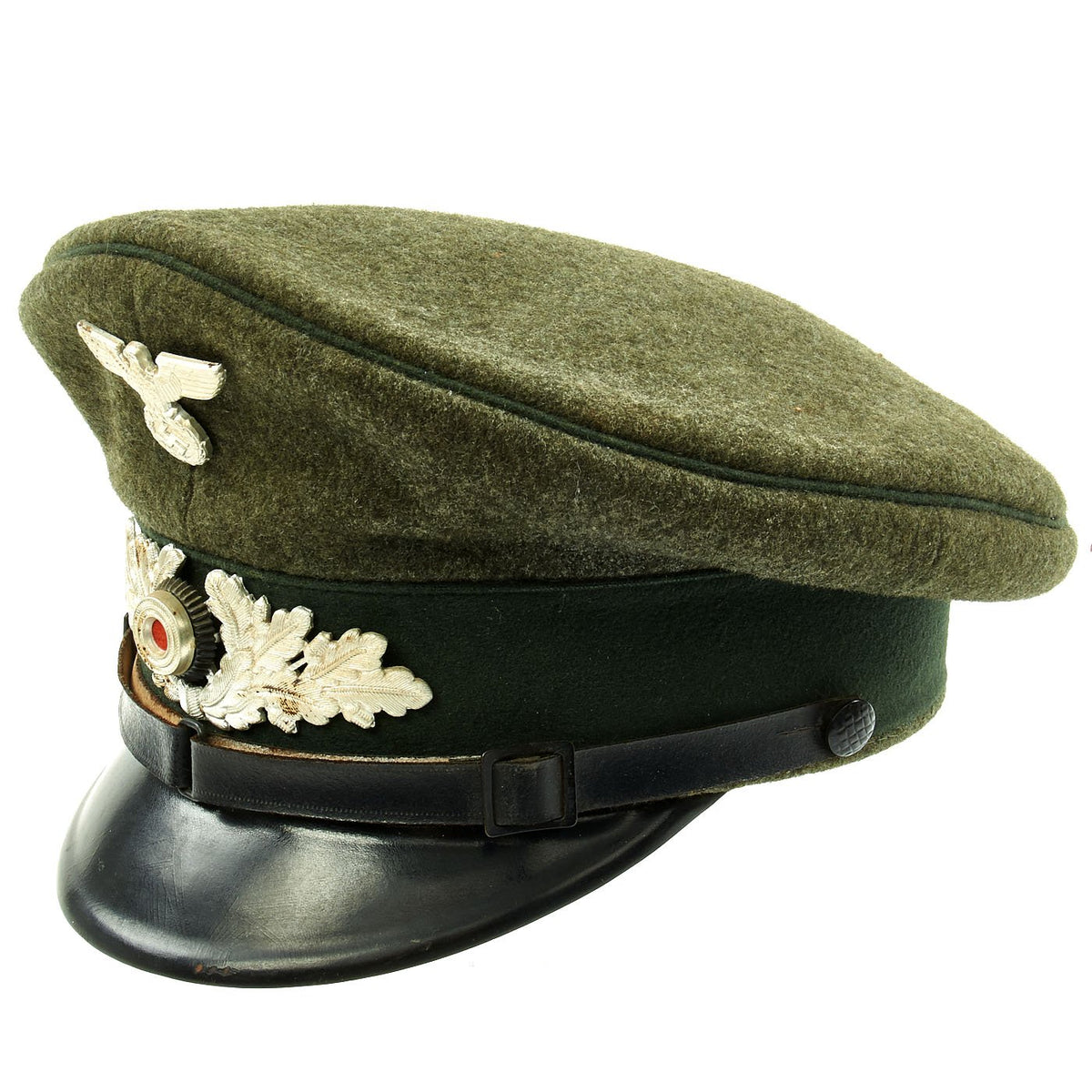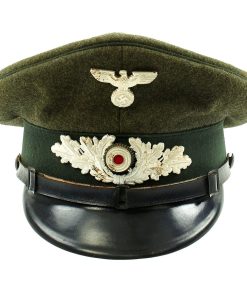Original German WWII Forestry Service Official Visor Cap by G. Aschenneller Original Items
$ 595,00 $ 178,50
Original Item: Only One Available. During the Pre-WWII years in Germany, virtually all aspects of the government fell under control of the NSDAP, and the Forestry service was no exception. Germany has a long tradition of hunting, and has many famous forest areas throughout the country. The government set up an office of forestry to help manage the natural resources. Upon the arrival of the Third Reich, forestry uniforms were outfitted with swas symbols, resulting in items like this Forestry Official Schirmmütze (Peaked Cap).
The design of the caps were not nearly as standardized as the Army or Airforce, so the colors used could vary from gray to green, to black for the band. What remained the same for all however was the dark “forest green” piping used around the top of the crown, and around the central band. This example is almost entirely forest green, with the crown body having a slightly lighter color with more gray. It has the standard “vulcanfibre” peak / visor, with a leather sweatband and cloth lining.
It is decorated with a well detailed silvered aluminum eagle insignia on the front crown, which faces to the left, correct for the forestry service. There is also a very nice silvered aluminum forestry oak leaf wreath surrounding a tri-color cockade on the band. The dual-buckled black leather chinstrap, is attached to black lacquered buttons on either side. Normally this would be for an EM/NCO, but we do not know whether the forestry service had such a type of command structure. The brown leather sweatband does show wear, and unfortunately has cracked through in many places.
The crown celluloid diamond is intact, and still has the manufacturers name and address in gold print:
Mützenfabrik
G. Aschenneller
München 2. N. W.
Amalienstr. 18
The cap shows only light wear, mostly around the edge, and some minor moth nips, overall very nice condition as pictured. There is deterioration to the stitching holding in the visor, typical of these caps.
A very nice example of a classic hat worn by the German Forestry Service during WWII.
The Forstverein (Forestry Association) was a civil union, founded in 1899, whose members were either Foresters or Forest owners and was founded to give more “power” to their interests when dealing with the Governments of the states or the Reich. Their “targets” were mainly economical with some “spreads” of caring for nature and forests. The aim of the association was: to take care of the German forest, the promotion of forest economy and science and the exchange of personal ideas. After the NSDAP took over Germany, the various Forestry Groups were folded under the NSDAP umbrella.
The Forstschutzkommando (FSK), or simply Forstschutz was a uniformed and armed para-military security formation raised in late 1939. Composed of some 10,000 volunteers, it was recruited from forestry officials and forest workers and headed by Landesforstmeister Ernst Boden. Hermann Göring, as the Reichsforstmeister, was its “supreme commander”.
After having received brief training, the first 2,000 so-called Forstschützen were put into action in wooded areas in occupied Poland. Here, they provided security for lumber transports and -storage places and sawmills, as well as being employed to combat wood-thieves and poachers and to arrest “unauthorized” persons in the forests. They were authorized to use firearms in the case of resistance or attempted escapes.
In July 1941, the Forstschutz took charge of the Bialowies forest, a former hunting ground of the Czar and important area for the lumber industry. The civilian population was evacuated from Göring’s new Reichsforst, with their villages and farms being burnt to the ground and two small Jewish communities being liquidated as well.
In the summer of 1942, Forstschutz units were dispatched to the Reichs Commissariats of “Ostland” and the Ukraine. Here, they were used in anti-partisan operations, suffering significant casualties in the process themselves.
Apart from their original security tasks and anti-partisan operations, Forstschutz personnel were involved in the capture and liquidation of Jews, who had managed to keep from being arrested or who had escaped from Ghettoes and were hiding in the forests. Apparently, Forstschutz men were also actively involved in the liquidation of Jewish Ghettoes if regular SS- and Police forces were not available.
Later, during the large-scale German fighting retreat, Forstschutz units even participated in military combat engagements in an infantry role.
Fast Shipping with Professional Packaging
Thanks to our longstanding association with UPS FedEx DHL, and other major international carriers, we are able to provide a range of shipping options. Our warehouse staff is expertly trained and will wrap your products according to our exact and precise specifications. Prior to shipping, your goods will be thoroughly examined and securely secured. We ship to thousands clients each day across multiple countries. This shows how we're dedicated to be the largest retailer on the internet. Warehouses and distribution centres can be located throughout Europe as well as the USA.
Note: Orders with more than one item will be assigned a processing date depending on the item.
Before shipping before shipping, we'll conduct a thorough inspection of the items you have ordered. Today, the majority of orders will be delivered within 48 hours. The delivery time will be between 3-7 days.
Returns
The stock is dynamic and we cannot completely manage it because multiple stakeholders are involved, including our factory and warehouse. So the actual stock may alter at any time. It's possible that you may not receive your order once the order has been made.
Our policy is valid for a period of 30 days. If you don't receive the product within 30 days, we are not able to issue a refund or an exchange.
You can only return an item if it is unused and in the same state as the day you received it. You must have the item in its original packaging.
Related products
Uncategorized
Uncategorized
Band of Brothers ORIGINAL GERMAN WWII Le. F.H. 18 10.5cm ARTILLERY PIECE Original Items
Uncategorized
Uncategorized
Uncategorized
Uncategorized
Armored Burgonet Helmet & Polearm from Scottish Castle Leith Hall Circa 1700 Original Items
Uncategorized
Uncategorized
Uncategorized
Uncategorized
Uncategorized
Uncategorized
Uncategorized
Uncategorized
Uncategorized
Uncategorized
Uncategorized
Armoured Fighting Vehicles of the World: AFVs of World War One (Hardcover Book) New Made Items












































































